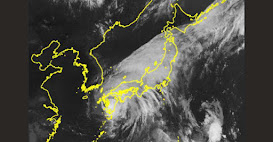How climate change makes typhoons stronger: the case of Shanshan in Japan
Climate change is increasingly affecting weather patterns around the world, with some of the most dramatic changes occurring in regions like Japan. In recent years, the frequency and intensity of typhoons has become more prominent, leading to devastating effects on the country. One such example is Typhoon Shanshan which swept through Japan with unprecedented force, causing severe flooding and landslides But what makes Shanshan particularly remarkable is how its behavior underscores the broader impact of climate change.
How climate change is shaping typhoon patterns
Typhoon Shanshan moved across Japan at breakneck speed, raising the risk of flooding and landslides. According to experts, such rapid movement can be partly explained by global warming. Dr. Ito, a well-known Japanese meteorologist, notes that the westerlies—the steady wind that blows from west to east in the mid-latitudes—have shifted northward in Japan. This change is due to an increase in the temperature of the ocean in the Sea of Japan.
In mid-August, shortly before Shanshan made landfall, the weather agency reported that sea temperatures in the Sea of Japan were 2-3°C warmer than a normal year, with temperatures reaching 5 degrees in some areas near the Korean Peninsula. °C above. An analysis by Imperial College London found that due to climate change, the likelihood of damaging Shanshan winds was 26% higher. These data indicate a direct relationship between rising temperatures and stronger typhoons.
The economic imperative of Japan's gas investments
Despite the obvious risks of climate change, Japan continues to invest heavily in fossil fuels, including natural gas. This decision was driven by the need to provide energy for the domestic market and meet the growing needs of developing countries. Japan's gas promotion generated $14 billion in revenue last year alone, reinforcing its reliance on fossil fuels, even as climate experts call for a faster transition to renewable energy.
According to Manabu Kato of the Japan Bank for International Cooperation, a pragmatic energy transition that supports gas alongside renewables is important. "For countries like India, gas will still be needed after 2050," Kato says, stressing that navigating the global energy landscape requires a balanced approach.
Why Japan's strategy is criticized
Japan's decision to double its investment in natural gas has not been without criticism. Environmentalists say Japan's actions are at odds with global efforts to reduce greenhouse gas emissions. By prioritizing short-term economic benefits over long-term environmental sustainability, Japan risks worsening climate conditions that make disasters like Typhoon Shanshan more frequent and severe.
Critics say Japan's strategy reflects a reluctance to fully exploit renewable energy sources that could provide more sustainable economic benefits in the long term. Although Japan remains a critical player in the global energy market, its current path could undermine global climate goals and lead to worse weather conditions in the future.
The case of Typhoon Shanshan highlights a critical moment in Japan's approach to climate change and energy policy. As the world grapples with the urgent need to combat global warming, Japan's decisions will have far-reaching consequences not only for its own future, but also for global resilience to climate change. By balancing its energy needs with more aggressive investment in renewable resources, Japan has the opportunity to become a leader in creating a more sustainable world. Until then, the threat of more powerful storms like Shanshan looms on the horizon.
Personal opinion
From my perspective, Japan's current strategy of investing heavily in natural gas while acknowledging the risks of climate change seems counterintuitive. While it is clear that transitioning to renewable energy will take time and careful planning, prioritizing short-term economic benefits can undermine long-term sustainability efforts. As climate change continues to affect global weather patterns, it is imperative for countries like Japan to take a more proactive stance in implementing renewable energy solutions to reduce future risks and set an example for the rest of the world.




Comments
Post a Comment